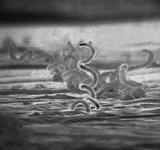
Syphilis
Overview
Syphilis is a sexually transmitted infection caused by the spirochete bacterium Treponema pallidum
subspecies pallidum. The primary route of transmission is through sexual contact; however, it may also be transmitted from mother to fetus during pregnancy or at birth, resulting in congenital syphilis
. Other human diseases caused by related Treponema pallidum include yaws
(subspecies pertenue), pinta
(subspecies carateum) and bejel
(subspecies endemicum).
The signs and symptoms of syphilis vary depending in which of the four stages it presents (primary, secondary, latent, and tertiary).
Treponema pallidum
Treponema pallidum is a species of spirochaete bacterium with subspecies that cause treponemal diseases such as syphilis, bejel, pinta and yaws. The treponemes have a cytoplasmic and outer membrane...
subspecies pallidum. The primary route of transmission is through sexual contact; however, it may also be transmitted from mother to fetus during pregnancy or at birth, resulting in congenital syphilis
Congenital syphilis
Congenital syphilis is syphilis present in utero and at birth, and occurs when a child is born to a mother with secondary syphilis. Untreated syphilis results in a high risk of a bad outcome of pregnancy, including mulberry molars in the fetus. Syphilis can cause miscarriages, premature births,...
. Other human diseases caused by related Treponema pallidum include yaws
Yaws
Yaws is a tropical infection of the skin, bones and joints caused by the spirochete bacterium Treponema pallidum pertenue...
(subspecies pertenue), pinta
Pinta (disease)
Pinta is a human skin disease endemic to Mexico, Central America, and South America. It is caused by infection with a spirochete, Treponema pallidum carateum, which is morphologically and serologically indistinguishable from the organism that causes syphilis.-Presentation:Pinta is thought to be...
(subspecies carateum) and bejel
Bejel
Bejel, or endemic syphilis, is a chronic skin and tissue disease caused by infection by a subspecies of the spirochete Treponema pallidum....
(subspecies endemicum).
The signs and symptoms of syphilis vary depending in which of the four stages it presents (primary, secondary, latent, and tertiary).

